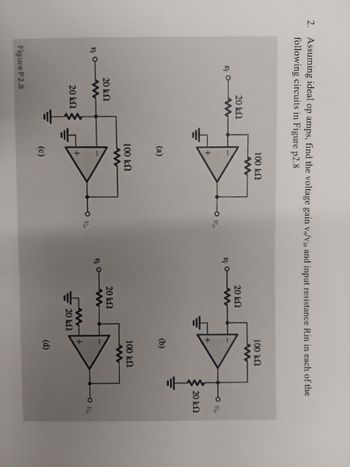
Introductory Circuit Analysis (13th Edition)
13th Edition
ISBN: 9780133923605
Author: Robert L. Boylestad
Publisher: PEARSON
expand_more
expand_more
format_list_bulleted
Concept explainers
Question

Transcribed Image Text:**Problem 2: Operational Amplifier Circuits Analysis**
Assuming ideal operational amplifiers (op amps), find the voltage gain \( \frac{v_0}{v_{in}} \) and input resistance \( R_{in} \) in each of the following circuits in Figure P2.8.
**Figure P2.8: Operational Amplifier Circuits**
- **(a)** The circuit features an inverting configuration:
- The non-inverting input (+) is grounded.
- The inverting input (-) is connected via a 20 kΩ resistor to the input voltage \( v_{in} \).
- A feedback resistor of 100 kΩ is connected from the output \( v_0 \) to the inverting input (-).
- **(b)** This circuit is a non-inverting configuration:
- The non-inverting input (+) is connected to the input voltage \( v_{in} \) via a 20 kΩ resistor.
- The inverting input (-) is grounded through the same 20 kΩ resistor.
- A feedback resistor of 100 kΩ is connected from the output \( v_0 \) to the inverting input (-).
- **(c)** This represents another inverting amplifier setup:
- The non-inverting input (+) is grounded.
- The input voltage \( v_{in} \) is connected to the inverting input (-) via a 20 kΩ resistor.
- There is a feedback resistor of 100 kΩ from the output \( v_0 \) to the inverting input (-).
- An additional 20 kΩ resistor is connected from the + power supply to the inverting input (-).
- **(d)** This circuit illustrates a non-inverting amplifier configuration:
- The input voltage \( v_{in} \) is connected directly to the non-inverting (+) input.
- A 20 kΩ resistor is connected from the inverting input (-) to the ground.
- A feedback resistor of 100 kΩ is connected from the output \( v_0 \) to the inverting input (-).
- Another 20 kΩ resistor is connected from the + power supply to the inverting input (-).
**Task:**
Analyze each circuit given the ideal op-amp conditions, determining the voltage gain \( \frac{v_0}{v_{in}} \) and input resistance
Expert Solution
This question has been solved!
Explore an expertly crafted, step-by-step solution for a thorough understanding of key concepts.
This is a popular solution
Trending nowThis is a popular solution!
Step by stepSolved in 4 steps with 4 images

Knowledge Booster
Learn more about
Need a deep-dive on the concept behind this application? Look no further. Learn more about this topic, electrical-engineering and related others by exploring similar questions and additional content below.Similar questions
- 2) The circuit shown below uses a diode in the feedback path of the op amp. For each question, use only the ideal switch model to analyze the circuit's behavior (i.e. ignore the diode's 0.7V forward drop). Assume that R = 1k2, and the op amp is ideal. D VOUT VIN a) Suppose vIN=2V. What direction is the current i passing through R? Is the dio ON or OFF? Wha VOUT b) Suppose VIN = -2V. What direction is the current i passing through R? Is the diode ON or OFF? What is voUT? c) Explain why VOUT can never be less than 0V.arrow_forwardRs R1 Vio W R4 o Vo R2 Given that V1= 10 V R1 = 30 R2 = 42 R3 = 20 R4 = 32 R5 = 32 For the ideal op-amps, determine Vo in Volts. Round your answer to the nearest single digit place and do not enter units.arrow_forwardDerive the output voltage (Vol, Voz and Vas) of cach Op-Amp in Figure QI. Va Ra Rb U1 ww Vo1 U2 Vb VO2 Ry Rx Rd U3 VO3 4 RI Figure QIarrow_forward
Recommended textbooks for you
 Introductory Circuit Analysis (13th Edition)Electrical EngineeringISBN:9780133923605Author:Robert L. BoylestadPublisher:PEARSON
Introductory Circuit Analysis (13th Edition)Electrical EngineeringISBN:9780133923605Author:Robert L. BoylestadPublisher:PEARSON Delmar's Standard Textbook Of ElectricityElectrical EngineeringISBN:9781337900348Author:Stephen L. HermanPublisher:Cengage Learning
Delmar's Standard Textbook Of ElectricityElectrical EngineeringISBN:9781337900348Author:Stephen L. HermanPublisher:Cengage Learning Programmable Logic ControllersElectrical EngineeringISBN:9780073373843Author:Frank D. PetruzellaPublisher:McGraw-Hill Education
Programmable Logic ControllersElectrical EngineeringISBN:9780073373843Author:Frank D. PetruzellaPublisher:McGraw-Hill Education Fundamentals of Electric CircuitsElectrical EngineeringISBN:9780078028229Author:Charles K Alexander, Matthew SadikuPublisher:McGraw-Hill Education
Fundamentals of Electric CircuitsElectrical EngineeringISBN:9780078028229Author:Charles K Alexander, Matthew SadikuPublisher:McGraw-Hill Education Electric Circuits. (11th Edition)Electrical EngineeringISBN:9780134746968Author:James W. Nilsson, Susan RiedelPublisher:PEARSON
Electric Circuits. (11th Edition)Electrical EngineeringISBN:9780134746968Author:James W. Nilsson, Susan RiedelPublisher:PEARSON Engineering ElectromagneticsElectrical EngineeringISBN:9780078028151Author:Hayt, William H. (william Hart), Jr, BUCK, John A.Publisher:Mcgraw-hill Education,
Engineering ElectromagneticsElectrical EngineeringISBN:9780078028151Author:Hayt, William H. (william Hart), Jr, BUCK, John A.Publisher:Mcgraw-hill Education,

Introductory Circuit Analysis (13th Edition)
Electrical Engineering
ISBN:9780133923605
Author:Robert L. Boylestad
Publisher:PEARSON

Delmar's Standard Textbook Of Electricity
Electrical Engineering
ISBN:9781337900348
Author:Stephen L. Herman
Publisher:Cengage Learning

Programmable Logic Controllers
Electrical Engineering
ISBN:9780073373843
Author:Frank D. Petruzella
Publisher:McGraw-Hill Education

Fundamentals of Electric Circuits
Electrical Engineering
ISBN:9780078028229
Author:Charles K Alexander, Matthew Sadiku
Publisher:McGraw-Hill Education

Electric Circuits. (11th Edition)
Electrical Engineering
ISBN:9780134746968
Author:James W. Nilsson, Susan Riedel
Publisher:PEARSON

Engineering Electromagnetics
Electrical Engineering
ISBN:9780078028151
Author:Hayt, William H. (william Hart), Jr, BUCK, John A.
Publisher:Mcgraw-hill Education,